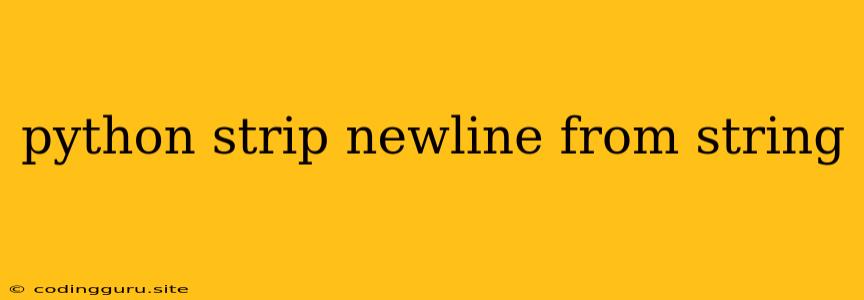How to Remove Newlines from Strings in Python
In Python, strings often contain newline characters (\n) which can be a nuisance when you want to manipulate or display the data neatly. This is especially true when you're working with text files or data scraped from the web. So, how do you get rid of these pesky newline characters?
Let's explore some common methods to strip newline from string in Python:
1. Using strip()
The strip() method in Python removes leading and trailing whitespace characters, including newline characters.
Example:
my_string = "Hello\nWorld!"
stripped_string = my_string.strip()
print(stripped_string) # Output: Hello World!
Key points:
strip()only removes leading and trailing newlines.- It will not remove newline characters in the middle of the string.
2. Using replace()
The replace() method allows you to replace all occurrences of a specific character with another. In this case, we'll replace \n with an empty string.
Example:
my_string = "Hello\nWorld!"
stripped_string = my_string.replace("\n", "")
print(stripped_string) # Output: Hello World!
Key points:
replace()works for any character you want to remove.- It replaces all occurrences of the character, including those within the string.
3. Using splitlines() and joining
This method splits the string into a list of lines using the newline character as a delimiter. Then, you can join the list elements back into a single string without the newline characters.
Example:
my_string = "Hello\nWorld!"
lines = my_string.splitlines()
stripped_string = "".join(lines)
print(stripped_string) # Output: Hello World!
Key points:
- This method is particularly useful for preserving line breaks within the string.
- It provides more control over how the lines are combined back into a string.
4. Using re.sub()
The re.sub() function from the re module allows you to perform regular expression substitutions. You can use it to remove all occurrences of the newline character (\n).
Example:
import re
my_string = "Hello\nWorld!"
stripped_string = re.sub(r'\n', '', my_string)
print(stripped_string) # Output: Hello World!
Key points:
- This method offers advanced string manipulation capabilities using regular expressions.
- It allows for more complex patterns to be matched and replaced.
5. Using List Comprehensions
List comprehensions offer a concise and efficient way to remove newline characters from strings.
Example:
my_string = "Hello\nWorld!"
stripped_string = "".join([line for line in my_string.splitlines() if line.strip()])
print(stripped_string) # Output: Hello World!
Key points:
- This method uses list comprehensions for clear and concise string manipulation.
- It provides a more functional approach to removing newline characters.
Which method should I choose?
The choice of method depends on your specific needs and the structure of your data:
- For removing leading and trailing newlines: Use
strip(). - For replacing all occurrences of newline characters: Use
replace(). - For preserving line breaks while removing newlines: Use
splitlines()andjoin(). - For advanced string manipulation and regular expression-based replacements: Use
re.sub(). - For concise and efficient solutions using list comprehensions: Use list comprehensions.
Conclusion
Removing newline characters from strings is a common task in Python. Understanding the various methods available, along with their pros and cons, empowers you to choose the most efficient and appropriate approach for your situation. By applying these techniques, you can effectively strip newline from string and achieve the desired results for your string manipulation needs.
